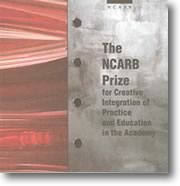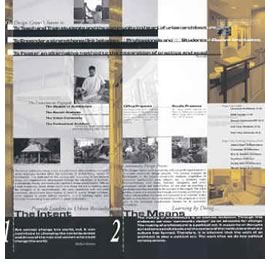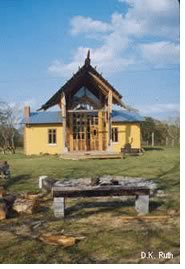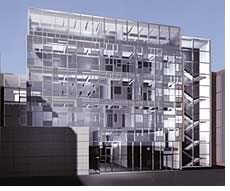
Awards honor creative integration of practice and education in the academy
The National Council of Architectural Registration Boards (NCARB) is calling for entries for its second annual NCARB Prize for Creative Integration of Practice and Education in the Academy. The prize honors innovative ways of integrating practitioners into the academy to expose students to the reality and culture of day-to-day practice. Entries are due February 4, 2003.
 Peter
Steffian, FAIA, one of the jurors, writes that the NCARB Prize, established
this year, was inspired by the 1996 book Building
Community: A New Future for Architecture Education, by the late
Ernest Boyer and Lee Mitgang of the Carnegie Foundation for the Advancement
of Teaching. "Several threads emerged from the discussions surrounding
this study," according to Steffian, "and one in particular drew
the attention of the collateral organizations: Practice
could be integrated into education."
Peter
Steffian, FAIA, one of the jurors, writes that the NCARB Prize, established
this year, was inspired by the 1996 book Building
Community: A New Future for Architecture Education, by the late
Ernest Boyer and Lee Mitgang of the Carnegie Foundation for the Advancement
of Teaching. "Several threads emerged from the discussions surrounding
this study," according to Steffian, "and one in particular drew
the attention of the collateral organizations: Practice
could be integrated into education."
On its maiden voyage this year, the NCARB Prize program drew 48 entries from 47 of the 113 NAAB-accredited programs in architecture. Director of Professional Services Michiel M. Bourdrez, AIA, reports that the NCARB Board of Directors was well pleased with the caliber of entries this year and has decided to fund the prize to the same level for 2003: $25,000 for the grand prize winner, and $7,500 each for the other five winners.
Submission criteria
Architecture schools with NAAB-accredited programs are invited to submit
projects complete or in progress by the end of the 2002 fall term that
respond to the integration of education with practice. Acceptable work
may include comprehensive studio projects, community design charrettes,
and other joint academic venues for practitioner, faculty, and student
interaction. Areas of practice that can be represented include (but are
not limited to) leadership, ethics, sociology, economics, politics, law,
public benefit, project development, practice management, infrastructure/context,
allied/affiliate-professional endeavors, building systems, research, and
sustainability.
Entries must include a one-page abstract, a maximum of seven pages of detailed program descriptions, and visual presentations on one or two 30x30-inch foam boards. Entries also must be submitted in electronic form for future publication.

2002 winners
The 2002 NCARB Prize winners are:
 •
Grand Prize: University of Detroit Mercy for the "Detroit Collaborative
Design Center," a year-round nonprofit center engaging students,
faculty, practitioners, and community residents in finding design solutions
to locally generated urban concerns
•
Grand Prize: University of Detroit Mercy for the "Detroit Collaborative
Design Center," a year-round nonprofit center engaging students,
faculty, practitioners, and community residents in finding design solutions
to locally generated urban concerns
• Arizona State University, for "Stripscape: Pedestrian Amenities Along the Avenue," a faculty-led project involving an interdisciplinary team of students to propose alternatives to traditional urban development for merchants along Phoenix's 7th Avenue commercial core
 •
Auburn University, for "The Rural Studio," created by professors
Dennis K. Ruth and the late Samuel Mockbee, FAIA, which offers architecture
students hands-on experience in design and building structures for poor
people in Hale County, Ala.
•
Auburn University, for "The Rural Studio," created by professors
Dennis K. Ruth and the late Samuel Mockbee, FAIA, which offers architecture
students hands-on experience in design and building structures for poor
people in Hale County, Ala.
• Miami University, for "Toward a More Mutual Partnership: Pushing the Boundaries of the Internet Studio," which teams architecture and interior design students to create real-life projects in two different professional offices and allows practitioners to critique work daily—via the Web—within their own schedules
• North Carolina State University, for "Case Studies," through which three- or four-person teams of graduate-level professional practice students research and author case studies of real buildings with real clients
 •
University of Pennsylvania, for "Master(s) Building 2010: Transfer
Technologies in Architecture, Construction, and Production," through
which practitioners and faculty guide students to develop a new model
of architecture inspired by material and process transfer from other industries.
•
University of Pennsylvania, for "Master(s) Building 2010: Transfer
Technologies in Architecture, Construction, and Production," through
which practitioners and faculty guide students to develop a new model
of architecture inspired by material and process transfer from other industries.
Copyright 2002 The American Institute of Architects. All rights reserved.
![]()
|
For more information about the NCARB Prize, or to download an entry form, visit the NCARB Web site. The 2002 NCARB Prize jury was composed of members of NCARB's Practice
Education Task Force and deans of NAAB-accredited architecture programs: You can order Building Community from the AIA Bookstore, $13.50 AIA members/$15 retail (plus $6 shipping per order). Order online, phone 800-242-3837 option #4, or fax 202-626-7519. |
|